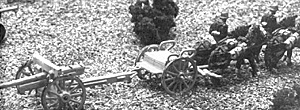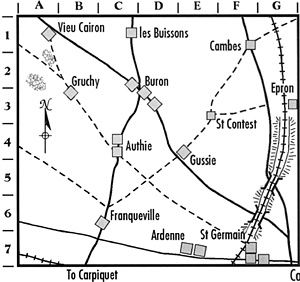
BACKGROUND
7th June, 1944. 3rd Canadian Infantry Division has not only successfully invaded Hitler's "Fortress Europe" on D-Day but has succeeded in penetrating farther into Normandy than any other Division coming off the beaches. However, its main objective – the city of CAEN was not reached on D-Day. It is now the morning after D-Day and the Division continues its attack. 3rd British Infantry Division is on its left flank, but doesn't advance. The airfields located near CARPIQUET west of CAEN are the Canadian's objectives. Ninth Infantry Brigade will launch its attack with the North Nova Scotia Highlanders (NNSH) Regiment moving out at 0800, supported by the Sherman tanks of the Sherbrooks Fusilers Regiment (SFR) and attached support elements from the 9th Brigade and SP guns of the 3rd ANTI-TANK REGIMENT. Although promised its support their supporting artillery was still on the beaches and would not be available (in range) until mid-afternoon. The supporting cruiser and destroyers they were told they would have would also be unavailable due to problems with the radios. NNSH and the SFR would be on their own.
Also unknown to 3rd Canadian the 12SS Hitler Jugend Panzer Division (HJPD) had moved into position south of their positions the night before. 12SS had orders to attack the same day – at 1600 hours 7 June, 1944 to be exact – as part of a three division German armored attack to throw the British and Canadians back into the sea. HJPD, 21st Panzer Division, and the PANZER LEHR Panzer Division were all to attack at 1600. The 25th Panzergrenadier Regiment (PGR) had dismounted and parked their trucks and were in their assembly areas waiting for the arrival of the II Panzer Battalion (Mark IV/H tanks). These tanks were just starting to arrive in the German grenadier's positions as the Canadians crossed their start lines. To the east other elements of 3rd Canadian held their positions, as did the British 3rd Infantry Division to the west. 26th PGR was positioned west of 25th PGR. 26th PGR would engage the Canadians that night and the next day. Today, 25th PGR would halt the Canadians, for the commander of the 25 PGR was watching the Canadian attack from the steeple of the Abby in FRANQUEVILLE. "Panzer" Meyer would launch an attack on the Canadians on his own initiative which would catch the Canadian NNSH and SFR with the II and III Panzergrenadier Battalions (PGB) and the II Panzer Battalion (PB).
This is the "historical" battle. The map shows the area the battle was fought in. The NNSH and SFR moved south past LES BUISSONS, BURON, AUTHIE, towards FRANQUEVILLE. The German II and III PGB were assembled just north of the road running east-west south of FRANQUEVILLE. II PB was located near ARDENNE. In SPEARHEAD terms, the Canadians had attack orders to take them south along the main north-south road going from LES BUISSONS to CARPIQUET, and the Germans were in RESERVE along row 6.
Strangely enough, the day AFTER the German counter-attack the British would attack with a force almost exactly the same size as the Canadians used the day before. The 2nd Battalion Royal Ulster Rifles and the tanks of the EAST RIDING YEOMANRY would attack, with artillery support, from the north table edge (E1-G1) south along the railroad towards ST GERMAIN and the western outskirts of CAEN. This attack would be met by III PGB 12SS HJPD and stopped. III PGR by then held ST CONTEST and EPRON.
Both the Canadian and British attacks are interesting from an historical viewpoint, but not very good convention games. The German force can use three to four commanders – 25 PGR Commander in overall command with the FLAK BATTALION and ARTILLERY BATTALION, and one commander for each combat battalion. On the other hand, the Canadians or the British have only two battalions allowing for only two players. Also, separately, neither attack really has a chance (although historically II Panzer Battalion had only half of its 96 tanks on 7th June, the others were under repair due to the long road march). For a convention game, I changed the battle. What if the 3rd British Division managed to move its attack up 24 hours and attacked at the side of 3rd Canadian Division? This would give me 4 Allied players, one per battalion, against the same number of Germans and a much more even battle. I also made II PB full strength so that German player would have a full battalion and to off-set the two Sherman tank battalions. That is the way the convention game was set up. For a historical game do the following:
CANADIAN FORCES ONLY: See the judge's page which tells you when the Canadian artillery is available. Sorry, no air support.
GERMANS: set up in and south of row 6 EXCEPT for the FLAK Battalion which was set up around AUTHIE and any RECON unit which can be north of that line. II Panzer Battalion is at half strength with 9 Mark IV/H (BN HQ-1, RECON PLT-1, 5 Tank Coy – 7 models total). German units orders are DEFEND for the FLAK battalion and the others are in RESERVE. The artillery battalion can be in general support or attached to one of the German combat battalions. Note: there is a platoon of German infantry in LES BUISSONS.
8th June 44
This can be run as a second game or follow-on to the first game using the German forces left from that game occupying the positions they ended up in during the first game, and on DEFEND orders (with a RESERVE per standard Spearhead rules).
BRITISH FORCE ONLY British attack enters table from north edge of columns E-G.
GERMAN FORCES located as follows::
- II PG BN in Gruchy-Buron area.
III PG BN in ST CONTEST-EPRON area.
II PZ BN (9 platoons) and FLAK BN attached to the PG BN.
Alternative: German locations are the positions reached in the Canadian game if that is run first.
 THE MAP
THE MAP
The map is quite bare but in actuality the terrain was ripe wheat fields, scattered copse of woods, open grazing land and tree lines. There were no hedgerows in this part of Normandy. I usually scatter small paper woods and depressions over the battlefield to break it up as well as put in wheat fields and small woods, and tree lines along the roads. The map only shows the main towns, main roads, and a few of the secondary roads. There are major fields to the west of the BURON-FRANQUEVILLE road indicated on my master map by a lot of secondary roads not on the game map. The ground is relatively flat.
More Caen 1944
Back to Table of Contents -- Courier #79
To Courier List of Issues
To MagWeb Master Magazine List
© Copyright 2000 by The Courier Publishing Company.
This article appears in MagWeb (Magazine Web) on the Internet World Wide Web.
Other military history articles and gaming articles are available at http://www.magweb.com